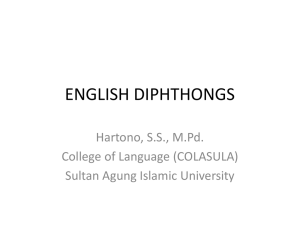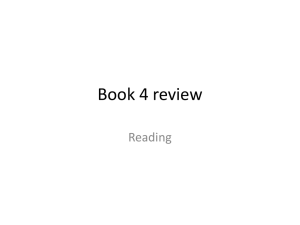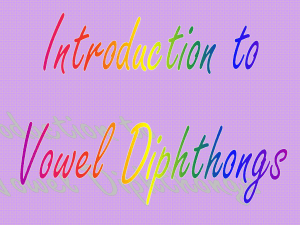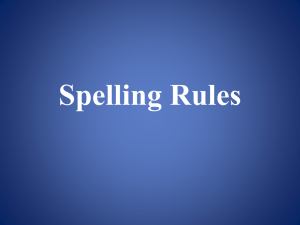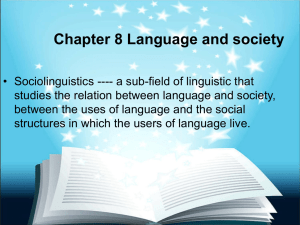Document
advertisement
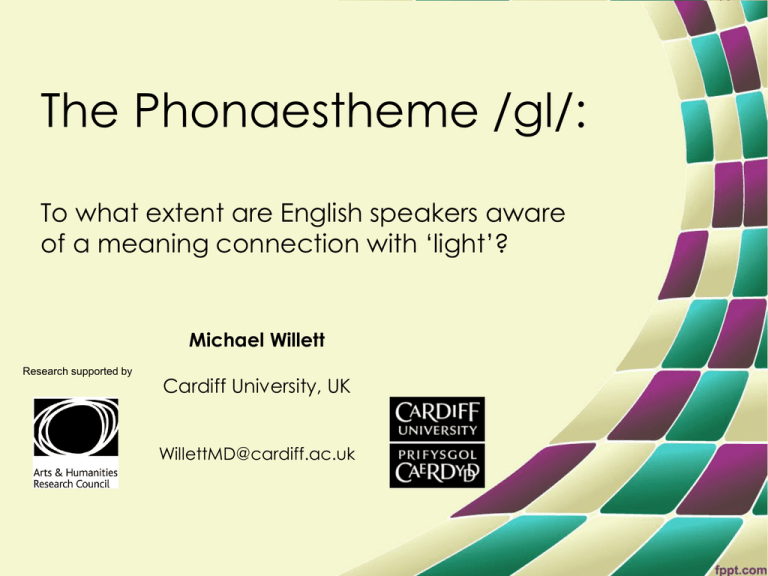
The Phonaestheme /gl/: To what extent are English speakers aware of a meaning connection with ‘light’? Michael Willett Research supported by Cardiff University, UK WillettMD@cardiff.ac.uk The Context of Phonaesthemes • Begins with J. R. Firth’s idea of prosodies • Prosodies are any functional units of sound that are not abstracted to the problematic level of discrete, individual sounds – i.e. the phoneme. Prosodies include intonation system, the syllable, etc. • Firth more convinced by idea of words as [groups of] syllables, themselves products of of phonetically-allowable ‘beginnings’ (onsets), middles (nuclei) and endings (codas) in the language than as a sum of individual, discrete phonemes Word analysed as series of Prosodies Gleam /gl/ = onset prosody /i:/ = vowel nucleus /m/ = coda prosody Defining Phonaesthemes • Firth (1930; 1957): A phonaestheme is what is formed when a prosody takes on ‘a cumulative suggestive value’– a connotation – for speakers, as a result of recurring in a range of English words that denote a broadly similar meaning • That is, speakers ‘hear and learn to make these sounds… [in similar] contexts of experience’ (1930:184-185). Onset /gl/ • Most widely-cited English phonaestheme • In English, the most common meaning denoted by words beginning /gl/ is ‘light’, or semanticallyrelated ideas, including ‘sight’ (Sturtevant, 1947; Marchand, 1966; Bowles, 1995; Sadowski, 2001) How frequently recurring? • 19 of the 59 (32%) head lexemes beginning /gl/ listed in the Compact OED denote a meaning related to ‘light’: • Glade, glamour, glance, glare, glass, glaucoma, glaze, gleam, glimmer, glimpse, glint, glisten, glister, glitter, glitz, gloaming, gloom, gloss, glow Defining Phonaesthemes • Phonaesthemes are not: Onomatopoeic (they do not mime in sound their denotations) - /gl/ cannot mime ‘light’! Iconic (there appears no conceived similarity between /gl/ and the real-world idea of ‘light’ that would make it more suitable than any other prosody) Universal (every language will have its own phonaesthemes, because they arise from forms’ denotations) Phonaesthemes and Arbitrariness • The existence of phonaesthemes does not pose a challenge to Saussure’s idea of the arbitrariness of linguistic signs • There is nothing initially about /gl/ to have made it any more suitable for denoting ‘light’ than any other prosody – e.g. /sp/ or /tr/ or /kw/ etc. • Phonaesthemes are diachronically nonarbitrary (over time they become non arbitrary and “more suitable” for use in /gl/ words by analogy to the existing, arbitrary forms) Existing Studies into /gl/ phonaestheme • All existing studies into /gl/ phonaestheme are “theoretical”; they look at the existing vocabulary of a language (usually English), and calculate how many of the /gl/-onset words denote a meaning of ‘light’ • However, this is not sufficient grounds to conclude that a /gl/ phonaestheme actually exists in that language… Existing Studies into /gl/ phonaestheme • …because phonaesthemes, as defined by Firth, involve speakers ascribing connotations to prosodies as a result of the contexts in which those prosodies frequently recur • Thus, in the words of Jespersen (1922a: 408), ‘the suggestiveness of [these sounds] as felt by presentday speakers…must be taken into account’ • No study to date addresses the /gl/phonaestheme from speakers’ perspectives Research Question • Do native English speakers connote the meaning ‘light’ more frequently than any other meaning, from words beginning with /gl/? Overview of Methodology • Three experiments given to 30 native English speakers, in the form of an online survey • Experimental cues taken from Abelin’s (1999) investigation into Swedish phonaesthemes – the only research to date that studies phonaesthemes productively • Two experiments are closed-ended multiple choice questions; one is fully open-ended. Experiment 1 • Respondents provided with audio recordings of three coined (‘nonsense’) words, and one image • The image depicts glittering, reflected sparkles of light • Only one of the ‘nonsense’ words features onset /gl/. The other two feature different onsets. All three feature identical nuclei and codas, to control for any extraneous phonaesthetic effects these prosodies may have. Experiment 1 (cont’d) • Respondents asked to listen to the audio recordings of ‘nonsense’ words, and choose whichever word they feel is most appropriate to name a specified part of the content in the image (the ‘light’ part) • If /gl/ phonaestheme is recognised by speakers, respondents should show a degree of preference for the /gl/-onset word to name the content in the image; the onsets are the only dimension on which each word varies from the others gless /ɡlɛs/ pless /plɛs/ fless /flɛs/ Experiment 2 • Designed to provide a re-test and add reinforcing evidence to that collected in Experiment 1 • Reverses the process of Experiment 1: Now, respondents provided with three images and single audio recording of a coined (‘nonsense’) word • Coined word features the /gl/ onset plus randomlychosen nucleus and coda • Only one of the images depicts a meaning associated with ‘light’. The other images depict unrelated meanings In theory, respondents should attribute coined word to this image (B), as it depicts glowing, shining stars gliss /glıs/ Experiment 3 • Fully open-ended • Respondents provided with a definition relating to the emission of light, and asked to coin (‘invent’) any word of their choosing to name this definition • If /gl/ phonaestheme recognised by speakers, respondents should prefer coining words with /gl/- to any other onset Experiment 1: Results • 25/30 respondents (83%) preferred using the coined word featuring /gl/- to describe the glittering eyeshadow Experiment 2: Results • 27/30 respondents (90%) preferred attributing the glittering stars image to the /gl/- word Experiment 3: Results • 12/30 (40%) respondents coined a word beginning /gl/ in response to definition • Given that there are at least 81 possible word onsets in English (Kreidler, 2004; Cruttenden, 2008); the fact that 40% of respondents all selected the same consonant cluster seems particularly high in a 30strong respondent cohort… Experiment 3: Results (cont’d) • Chart showing the frequency with which onsets were used by speakers in response to open-ended question: Is the phonaesthetic effect of /gl/ affected by the vowel(s) with which it is paired? • Experiment 2 sees a slight increase over Experiment 1 in the number of speakers associating /gl/ to the meaning of ‘light’ (compare 83% to 90%). • Experiments 1 and 2 use coined /gl/- words which are phonetically identical aside from their vowel nuclei: /glɛs/ in Experiment 1 (mid-front vowel) /glıs/ in Experiment 2 (high-front vowel) Is the phonaesthetic effect of /gl/ affected by the vowel(s) with which it is paired? • Further evidence that respondents prefer /gl/+highfront vowel from the words coined in Experiment 3 (insofar as the vowel graphemes can be interpreted)… Is the phonaesthetic effect of /gl/ affected by the vowel(s) with which it is paired? • Examining the /gl/ words coined by speakers in Experiment 3, and their inferred pronunciation: gloosie *at least 7 of the 12 words gliss /ɡlıs/ coined feature a high, front vowel – either /ı/ or /iː/ gleety /ɡliːtiː/ glite glinkel /ɡlınkəl/ glissipel /ɡlısıpɛl/ or /ɡliːsıpɛl/ if second <s> in second syllable glizon glizzen /ɡlızən/ or /ɡliːzən/ (as above) glind glisty /ɡlıstiː/ glissiant /ɡlısıənt/ or /ɡliːsıənt/ (as above) glastifer Concluding Remarks • /gl/ is consistently and strongly associated with ‘light’ by speakers across all experiments, showing evidence that English native speakers recognise its phonaesthetic function • However, it appears it has an even stronger association with ‘light’ for speakers if combined with a high-front vowel Experiment 2, with high front vowel nucleus, yields 7% more responses associating the phonaestheme to a meaning of ‘light’ than experiment 1, with mid-front vowel At least 7 of the 12 respondents who coin a /gl/ word in Experiment 3 use a high-front vowel • This finding seems to support Jespersen’s (1922b) claim that in many languages, high-front vowels tend to be associated with ‘lightness’ and low back vowels ‘darkness’ References • • • • • • • • • • • • Abelin, A (1999) Studies in Sound Symbolism. PhD thesis: Göteborg University. Bowles, H (1995) “The Semantic Properties of the Phonaestheme”. Studi italiani di linguistica teorica ed applicata, 1: 91-106. Cruttenden, A (2008) Gimson’s Pronunciation of English. London: Hodder Education. Firth, J R (1930) Speech. In Firth, J R, The Tongues of Men and Speech. London: Oxford University Press. Firth, J R (1957) Papers in Linguistics 1934-1951. London: Oxford University Press. Hayes, B (2009) Introductory Phonology. Oxford: Wiley-Blackwell. Jespersen, O (1922a) Language: Its Nature, Development and Origin. London: George Allen & Unwin Ltd. Jespersen, O (1922b) “Symbolic Value of the Vowel I”. In Jespersen, O, Selected Writings of Otto Jespersen. Abingdon: Routledge. Kreidler, C W (2004) The Pronunciation of English. Oxford: Blackwell. Marchand, H (1966) The Categories and Types of Present-Day English WordFormation. Alabama: University of Alabama Press. Sadowski, P (2001) “The sound as an echo to the sense: The iconicity of English glwords”. In Fischer, O and Nanny, M (eds.) The Motivated Sign. Amsterdam: John Benjamins. Sturtevant, E H (1947) An Introduction to Linguistic Science. New Haven, CT: Yale University Press.

